What, Exactly, Is Canadian Cuisine? Allow These 6 Restaurants to Show You
Liberated by life in a new country, immigrant communities are redefining what it means to eat well in Canada.
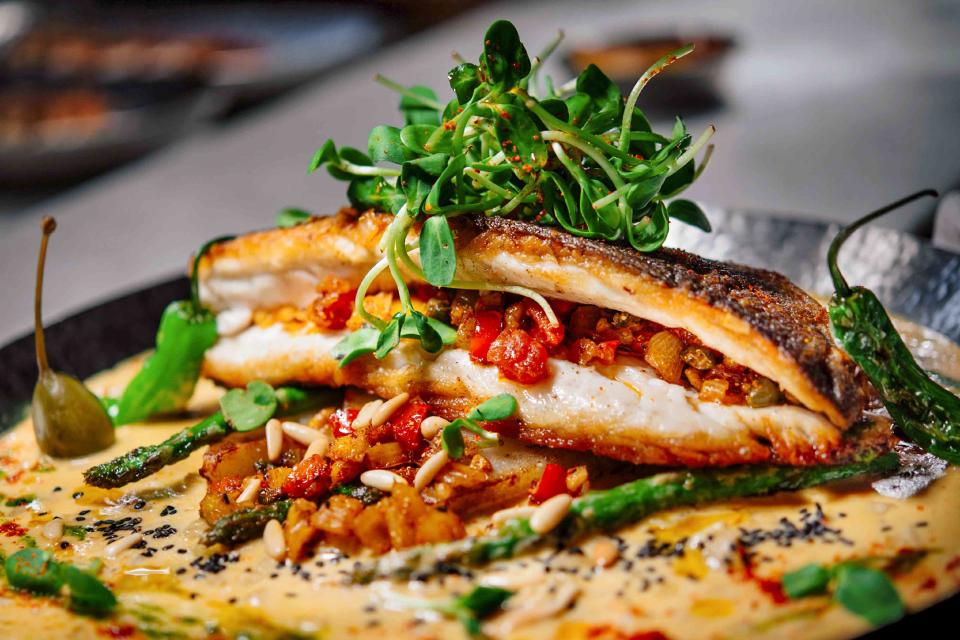
Courtesy of Damas
Stuffed sea bass with TajÃn sauce at Damas“What is Canadian cuisine? Does it even exist?” The French Moroccan couple, parents at my sons’ Montreal school, were genuinely curious, so I started to list iconic dishes: Quebecois poutine and tourtière (a savory meat pie); Acadian rappie pie (made with grated potatoes); cod tongues and toutons (fried bread) from Newfoundland; Indigenous herring roe on kelp. And what about Schwartz’s smoked meat, St-Viateur bagels, all the glories of Montreal deli culture? But then I gave up because I got their point.
Nobody in San Francisco or Shanghai or Zurich says: “Let’s go out for Canadian tonight!” Not the way they would for, say, Japanese sushi, or Neapolitan pizza. Modern Canada is a young nation; it hasn’t had time to develop a distinct culinary brand. Yet for anyone who values intense flavors and unbridled creativity, there’s no better place in the world to go out and eat right now than the cities of Canada.
Suburban Richmond, B.C., is widely thought to have the best Asian food in North America (see “Richmond’s Roots,” p. 12). The chefs at Canoe in Toronto, St. Lawrence in Vancouver, and River Café in Calgary bring French and Italian expertise to bear on such seasonal Canadian ingredients as line-caught fish, native game, and wild-foraged greens.
Canada is a place of multiplicities: Métis, Inuit, and more than 50 distinct First Nations form the cultural matrix in which waves of immigrants have learned to navigate French- and English-language institutions. This year, Canada’s population surged past 40 million, with much of the recent growth driven by refugees from Ukraine, Syria, Haiti, Iran, and Central and South America. What newcomers discover is that identities, techniques, and ingredients have a habit of mixing freely. Food lovers here can dig deeper into their traditions, discard them altogether, or transform them into something new and unexpected.
On a recent cross-country trip, I was served a dish that perfectly embodied this idea: a bowl of tajarin, a Piedmontese pasta made with an overabundance of butter and egg yolks, at Kissa Tanto in Vancouver. Chef Joël Watanabe’s father is Japanese, and his mother is French-Canadian, with roots in Corsica and Italy. In Watanabe’s hands, the fresh noodles are shot through with slices of shimeji and shiitake mushrooms that have been finished with Marsala, then topped with egg yolks cured in miso—two deeply internalized traditions melding to produce a cross-cultural study in umami.
“Fusion means forcing two things together, under immense pressure,” explains Watanabe. “I don’t do that. Sometimes a dish lands very Italian. Sometimes it lands very Japanese. But if it tastes good, then that’s where it’s at.”
Here are six unmissable restaurants that will give you an excellent idea of the expectation-busting, boundary-crossing work in progress that is Canadian cuisine today.
Kissa Tanto (Vancouver)
A purple neon sign on the main drag of Vancouver’s historic Chinatown invites diners up to Kissa Tanto’s second-floor dining room, where Noguchi paper lamps, framed Ponti prints, and pink vinyl banquettes conjure up a jazz café in 1960s Tokyo. “Please fix your hair, and remove the mud from your boots,” entreats a framed sign at the door, and on a recent visit, evening dresses and blazers filled the room. Chef Joël Watanabe started out in some of Montreal’s top Italian restaurants, running sushi bars as a side gig, and his Corsican and Japanese heritage manifests in dishes such as his carne cruda: thinly sliced Wagyu beef topped with Japanese pears, arima sansho seasoning, and a snowfall of shaved Parmesan cheese.
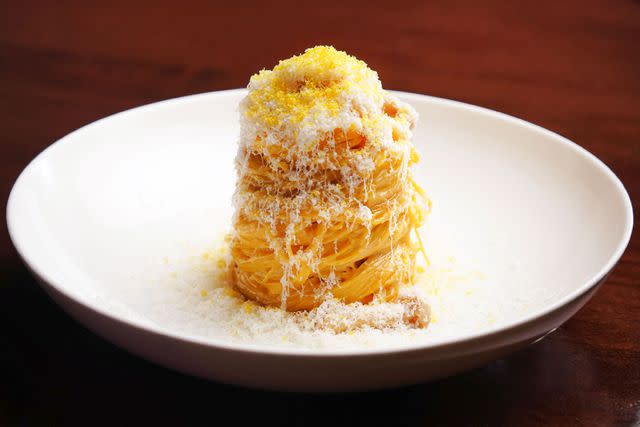
Hakan Burcuoglu
Italian and Japanese cultures combine in Kissa Tanto's tajarin, buttery pasta tossed with roasted shimeji and shiitake mushrooms and showered in Parmesan and miso-cured egg yolkMiss Likklemore's (Toronto)
For the roughly 350,000 people of Caribbean descent in Canada’s largest city, Miss Likklemore’s is the high-toned hot spot Toronto’s West Indian community has been waiting for. With its languidly spinning ceiling fans, potted succulents, and extensive wine and spirits list (curated by Canada’s first rum sommelier), Miss Likklemore’s is an elegant tribute to Caribbean cuisine. Chef Lonie Murdock puts slow-braised oxtail, jerk chicken, and crab XO on the pedestal they’ve always deserved, without omitting such crowd-pleasers as mac pie (a savory wallop of compressed macaroni and cheese) and co-owner Darren Hinds’ Guyana-born mother’s carrot cake.

Courtesy of Scale Hospitality
The crab XO with Carolina gold rice, snow crab, coconut, and cilantro from Miss LikklemoreâsKozak Homemade Ukraïnian Food (Vancouver)
“Kozak is the way we spell ‘Cossack,’ the Ukrainian warrior,” explains Sergiy Kuznetsov, who came to Canada with his wife, Irina Karpenko, from Kyiv in 2012. “The name conveys the proper vibes: fighting for freedom, being cheerful, and loving to feast.” The couple began by selling dark rye breads in farmers markets, but since Kozak opened its first brick-and-mortar location in Vancouver’s New West neighborhood, it has become a center for Canada’s Ukrainian diaspora, the largest outside Europe. Kozak’s mission is to re-create what Ukrainians ate before Communism, using Canadian ingredients. Their sourdough is made with Red Fife, a heritage wheat from Ontario; their lemon tarts are flavored with sea buckthorn, a tart berry introduced to Canada in the 1930s; their drinks list is heavy on housemade kvass, cloudy natural wines, and a custom “living beer” crafted by a Vancouver microbrewery; and their transcendent pierogies are stuffed with duck and elk.
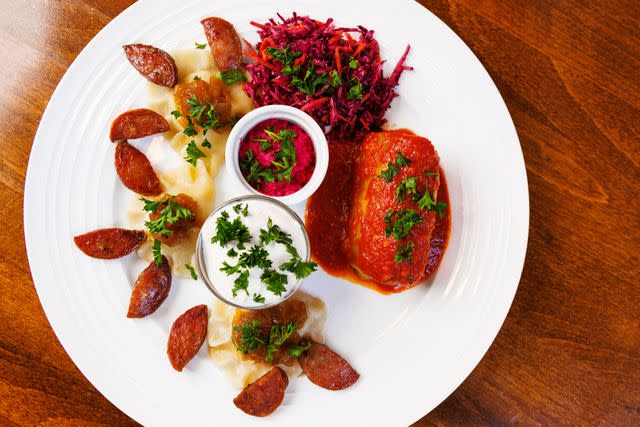
Courtesy of Kozak
A mixed plate at Kozak, including a cabbage roll, fried sausage, sauerkraut, and varenyky (Ukrainian pierogies)Beba (Montreal)
Chef Ariel Schor grew up in a Jewish family in Ushuaia, Argentina, the world’s southernmost city. After moving to Canada, he cut his teeth running Liverpool House, an offshoot of the influential Joe Beef (see “The Legacy of Joe Beef,” p. 10). At Beba, his intimate bistro on a quiet corner in the borough of Verdun, Schor plates sardines sourced from Japan, locally foraged mushrooms, and delicate gnudi made with ricotta and white asparagus. Nods to Schor’s heritage come in the form of duck-filled empanadas and a potato knish crowned with caviar, but Beba is more about a chef following his bliss down rabbit holes than ruminating about identity—which gets expressed on the plate anyway. “When you’re an immigrant,” says Schor, “and you have all this history behind you, it’s easier to communicate it through food than through talking.”
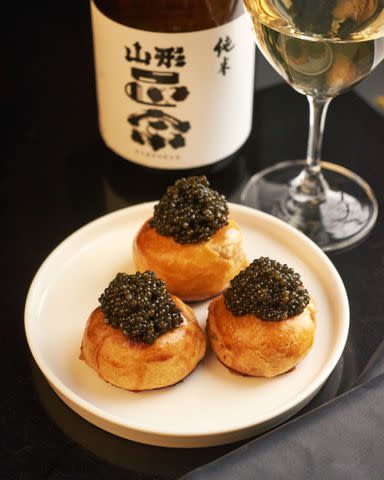
Matthew Perrin Photography
Chef Ariel Schor's knishes with caviar at Beba in MontrealDailo (Toronto)
Chef Nick Liu’s Cantonese father was born in India; his mother, part of China’s Hakka ethnic minority, was born in South Africa. Liu himself was born in Canada, but his training took place in Michelin-starred restaurants in Australia and Europe. In England, where he worked at Heston Blumenthal’s The Fat Duck, he had an epiphany as he watched his aunt whip up a late-night meal. “She opened the fridge, rolled out some dough, and within 15 minutes she’d made seven dishes.” Instead of scorning the home cooking he’d grown up with, Liu began to celebrate it. At DaiLo, beloved East Asian standards are reinterpreted through Liu’s French training and Chinese Canadian upbringing. Inspired by Paul Bocuse’s poulet en vessie, sliced black truffles are slipped beneath the skin of Hainanese chicken, which is then cooked sous vide; his Big Mac Bao is a sesame seed–topped bun filled with ground aged rib eye, nestled in Liu’s version of the fast-food “special sauce,” with Ontario cheddar standing in for processed cheese.
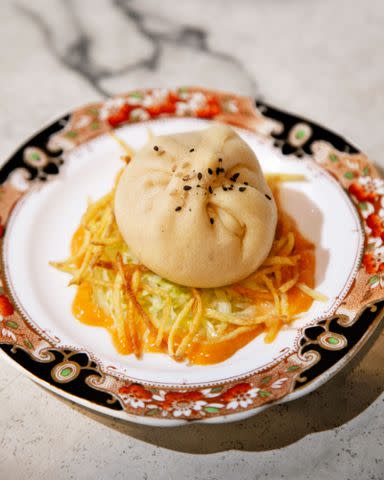
Joey Salmingo
Big Mac Bao with "special sauce" at DaiLoDamas (Montreal)
Since Syria’s civil war began in 2011, few foreigners have been able to discover its cuisine, which unites the ghee, lamb, and cheese of the subcontinent, the spice routes to the Far East, and the seafood- and olive oil–rich cuisine of the Mediterranean. Chef Fuad Nirabie, who was born in Calgary and studied filmmaking in Montreal, lived in his parents’ homeland as a young man, where he trained himself by following the historic route from Istanbul to Aleppo. A dinner at Damas is a pan-Ottoman feast, which might feature braised lamb from Alberta with Syrian smoked wheat, peas, nuts, and raisins; shish borek (lamb dumplings with sheep-milk yogurt sauce); and baked sea bass stuffed with sautéed peppers, capers, and seven spices. “I know a lot about Italian and French cooking, and I’m influenced by European presentation,” says Nirabie. “But the Ottoman world was huge and very cosmopolitan. That’s all the fusion I need.”
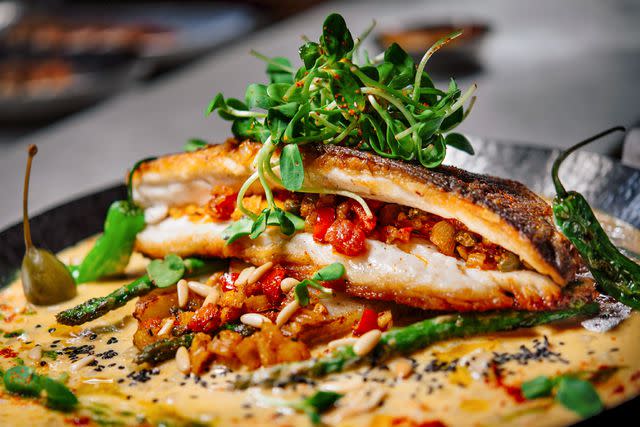
Courtesy of Damas
Stuffed sea bass with Tajìn sauce at DamasFor more Food & Wine news, make sure to sign up for our newsletter!
Read the original article on Food & Wine.

